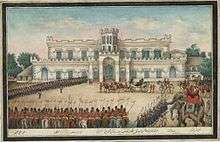Samuel Ludlow (surgeon)
Samuel Ludlow (died 1853) was a British surgeon in the East India Company medical establishment, serving in the Bengal Presidency in British India during the first half of the 19th century. Ludlow spent many years at the Delhi Residency, the headquarters of the British Resident to the Mughal Court in Delhi. The Resident's Office was created some time after 1803, when the British acquired Delhi, which soon became the Delhi Territory within the Ceded and Conquered Provinces, a part of the Bengal Presidency.

Ludlow joined the Bengal medical department (season of 1804) and was appointed Assistant Surgeon, First Class, on 18 March 1805.[1][2] In March 1806 he became Assistant Surgeon to the civil station of Benaras.[3] He was transferred to the Delhi Residency in 1813, and promoted to Surgeon on 30 January 1817.[4] In 1828, at the time of the wedding of his daughter, he was Presidency Surgeon at Delhi.[5] In 1831 he was appointed Superintending Surgeon and on 28 March of that year, transferred from Delhi to the Neemuch Division of the British Indian Army.[6] On 7 December 1835 he was appointed Superintending Surgeon, Agra Circle.[7] On 11 August 1838 he was transferred from the Agra circle to Superintending Surgeon, Sirhind Division, British Indian Army, based in Ambala.[8] Ludlow was appointed to the Bengal Medical Board and eventually retired from East India Company service and settled in Exeter.[9] In 1844, he was elected Fellow of the Royal College of Surgeons (Hon.), one of the original 300.[9][10] Sometime later, Samuel Ludlow moved to Bath, where he died on 17 October 1853 after a protracted illness.[9][11] His widow, Mary Ludlow, died in Cheltenham on 26 July 1870, aged 93.[12]
Ludlow is best known today for having constructed a house in the Civil Lines, just outside the city walls of Old Delhi, which was christened "Ludlow Castle," a play on words on his surname, the building's turret, its decorative crenelations, and the 11th-century Ludlow Castle, Shropshire. Ludlow Castle, Delhi, was later to become the Residency at Delhi, and, still later, in September 1857, be the site of a battery used by British troops in the Siege of Delhi to breach the city wall and retake the city.
See also
- Indian rebellion of 1857
Notes and references
- Campbell, Lawrence Dundas; Samuel, E. (editors) (1809). The Asiatic annual register, or, A View of the history of Hindustan, and of the politics, commerce and literature of Asia, Volume IX, for the year 1807. London: T Cadell and W. Davies (Booksellers to the Asiatic Society) in the Strand; and Black, Parry, and Kingsbury (Booksellers to the Honourable East India Company) in Leadenhall St. p. 176. Retrieved 25 September 2011.CS1 maint: extra text: authors list (link)
- The Bengal directory and annual register for the year 1838. Calcutta: Samuel Smith and Co. 1838. p. 238. Retrieved 25 September 2011.
- Campbell, Lawrence Dundas; Samuel, E. (1809). The Asiatic annual register: or, A view of the history of Hindustan, and of the politics, commerce and literature of Asia. Printed for J. Debrett. p. 154. Retrieved 27 September 2011.
- East-India register and directory for 1819. London: W.H. Allen. 1819. p. 112. Retrieved 24 September 2011.
- Blackwood's Edinburgh Magazine, Volume XXIII. Edinburgh: William Blackwood. January–June 1828. p. 662. Retrieved 25 September 2011.
- The Asiatic journal and monthly register for British and Foreign India, China, and Australasia, Volume VI. London: Wm. H. Allen & Co. September–December 1831. p. 135. Retrieved 25 September 2011.
- The Bengal directory and annual register for the year 1838. Calcutta: Samuel Smith and Co. 1838. p. 237. Retrieved 25 September 2011.
- Asiatic journal and monthly register for British and Foreign India, China, and Australasia, Volume XXVII New Series. London: Wm. H. Allen & Co. September–December 1838. p. 231. Retrieved 25 September 2011.
- The medical directory for Scotland. London: John Churchill. 1854. p. 180. Retrieved 27 September 2011.
- British and foreign medical review: or quarterly journal of practical medicine and surgery. London: John Churchill. 1844. p. 283. Retrieved 27 September 2011.
- The Gentleman's magazine. F. Jefferies. 1853. p. 651. Retrieved 26 September 2011.
- The Medical times and gazette. London: J. & A. Churchill. 1870. p. 197. Retrieved 27 September 2011.